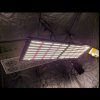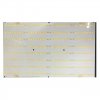nfhiggs
Well-Known Member
That's what I'm saying. Much more efficient to just make red photons directly, than it is to convert blue photons to red.If you want far red, then buy far red LEDs and don't waste all his energy in the phosphor layer
That's what I'm saying. Much more efficient to just make red photons directly, than it is to convert blue photons to red.If you want far red, then buy far red LEDs and don't waste all his energy in the phosphor layer
Nice find!
Seems my estimated numbers at half current are not so far off at all from this calculations.
~2,2μMolJ at nom. current and ~2,4 with half is not too shabby.
Samsung strips with additional deep- and far-red would be more efficient for sure, but the price point is not easily beatable. Okay, 12% more electricity adds up quickly, at least with high energy costs.
But where electricity is cheap upfront costs matter sometimes more and not to forget, there are only a few suitable CRI90 strips currently available.
What ever is available. If you can get strips with high efficient mono's, why not.Additional deep and far red monos or strips?
one * stands for a p value of <0.05 . which is still plenty significant.@tazztone
there is only one * at 800μMol/s/m²
That's simple, mate, there are no 680-700nm LED's available and 660 / 630nm is not that far off. You should not just look at the PSI/PSII peaks, but at the entire McCree curve.Hi everyone, I do have a question, might sound stupid.
Everyone talks about plants need light according to chlorophylls absorbtion maxima for chlorophyll a 430nm / 660nm and b 480nm / 660nm. Now the absorbtions maxima is just a value at which wavelength the molecule of chlorophyll a or b absorbs the highest amounts of light itself in a solution. Of we look at the photosystems I and II, the peaks of where chlorophyll a and b (mainly A) is using photons to help them converting oxigen and water to ATP or NADPH is at a wavelenth by 680nm (photosystem II) or 700nm (photosystem I). Instead of triggering these monochromatic wavelength, wavelength of 660/630nm gets pushed. How comes and why not the ones which gives you the highest benefit for the power used ?

Nice compilation of a wide assortment of those curves. Wonder how they ever arrived at that DIN5031-10-2000 curve.You should not just look at the PSI/PSII peaks, but at the entire McCree curve.
i think the best option to trigger wavelenghts > 660nm is a full spectrum of < 1800K pinkish whiteInstead of triggering these monochromatic wavelength


I use these in my flower tent. Im only just finishing up my first crop with them, but i havent really seen the things he is describing with the nodes and branches. The only plants of mine that had thin branches or spaced out nodes were the ones that werent close enough to the panels because they were shorter than the rest so they stretched a bit up to the light.QB 304 plus w 48 epistar 660nm..
View attachment 4256873 View attachment 4256874
What about these? @Randomblame do you think these would have that negative impact that you were describing?
What's their max wattageI use these in my flower tent. Im only just finishing up my first crop with them, but i havent really seen the things he is describing with the nodes and branches. The only plants of mine that had thin branches or spaced out nodes were the ones that werent close enough to the panels because they were shorter than the rest so they stretched a bit up to the light.
Ive been happy with the results from them so far, but I dont have much to compare it to personally.
I did this run with 16x of those 304+ boards in 3500k and knew it wasnt going to be enough for the results I wanted because I dont have enough wattage for my space, but they really surprised me and things went way better than I was expecting.
Will be adding 8 more 3000k 288 boards to my flower setup.
Bout to pull the trigger on (4) for a 4x4 tent, use a 600w driver??What's their max wattage
theyre 120w each.What's their max wattage
What about?theyre 120w each.
They use 1200ma each at max and require a 110v output from your drivers or 220v if you run them in series.
None of the HLG 600w drivers have an output voltage high enough and I havent looked at any other brands.
Theres not a driver that runs 4 of them near max well unless you have a 220v outlet imo. If you must have all 4 on 1 driver, a hlg-480H-C3500 is the most you can do with 110v. This will push 4 boards wired in parallel to around 78%
If you have a 220v outlet you could run 1 HLG-480H-C2100B with the boards wired in series-parallel and thatll push them pretty high around 87% i believe.
IMO the best driver for them is a HLG-240h-C2100 per 2 boards. One of them will push 2 boards at around 90% max and 2 of these are cheaper than 1 of the 480s.
Ive only looked at HLG drivers.Btw guys...
View attachment 4256906
Lol she wants me
Picked up (4) 304 w 660nm + (4) heatsinks now just scoping for the cheap driver..
I'm only using (4) per 16ft2, so I think ill want to drive them closer to 150w?? That sound right?Ive only looked at HLG drivers.
you need something with 110v output and close to either 2400ma or 4800ma the 110v output really limits HLG options.

